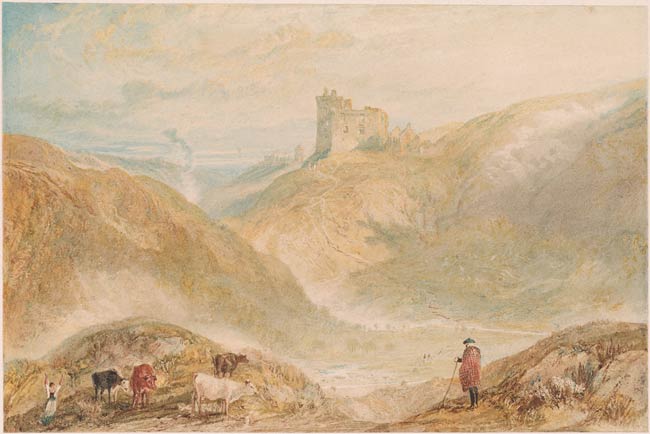
The drawing was produced on a commission from Sir Walter Scott in 1818 for The Provincial Antiquities of Scotland, a suite of engravings after drawings by Turner and other artists of Scottish monuments and landscapes with text by Scott. The suite, published in London, was issued in parts between 1819 and 1826. The engraving after the present drawing was published in Part II in August 1819 and appeared on page 51 of volume one. Two preliminary sketches for the drawing are known, both of about 1818-19: one, in Turner's "Scotland and London" Sketchbook, now in the Tate Gallery, London (inv. no. TB CLXX; Edinburgh 1999-2000, no. 15, repr.), and the other, Crichton Castle with Rainbow, in the Yale Center for British Art, New Haven (inv. no. B1977.14.6299; Edinburgh 1999-2000, no. 16, repr.).
Crichton Castle, in Midlothian, about ten miles south of Edinburgh, was built between the late fourteenth and late sixteenth centuries. It was the principal residence of James, 3rd Earl of Bothwell, third husband of Mary, Queen of Scots, and in the 1570s that of Francis Stewart, 5th Earl of Bothwell, who added the castle's piazza and courtyard modeled on the Palazzo dei Diamante in Ferrara, which was celebrated in Sir Walter Scott's poem Marmion. The castle still stands in a landscape largely unchanged since Turner's day.
Scott, Walter, 1771-1832 former owner.
Scott, Mary Monica Maxwell, former owner.
Brocklebank, Ralph, former owner.
Brocklebank, Thomas, former owner.
MacConnell, Rayner, former owner.
Tompkins, Francis, former owner.
Garnock, Viscountess, former owner.
Andrew Wilton, J. M. W. Turner: His Art and Life, New York, 1979, no. 1059, p. 425, repr.
Edinburgh, National Gallery of Scotland, Turner and Sir Walter Scott, exh. cat. by Katrina Thomson, 1999-2000, under no. 15, p. 81, as whereabouts unknown.
